1. What is vegetal chitosan?
Chitosan is a natural biopolymer that is primarily derived from chitin, which is the second most abundant natural polysaccharide after cellulose. Chitin is commonly found in the exoskeletons of crustaceans like crabs, shrimps, and lobsters, as well as in the cell walls of certain fungi like mushroom, aspergillus niger.
Structure and Properties:
- Chemical Structure: Chitosan is obtained by deacetylating chitin. This process involves removing acetyl groups from chitin, resulting in a polymer that has free amine groups.
- Solubility: Unlike chitin, chitosan is soluble in acidic to neutral solutions, making it more versatile for various applications.
- Biocompatibility and Biodegradability: Chitosan is known for its excellent biocompatibility and biodegradability. It’s non-toxic and can be broken down by natural biological processes.

Chitosan, sometimes known as deacetylated chitin, is a natural polycationic linear polysaccharide derived from partial deacetylation of chitin. Chitin is the structural element in the exoskeleton of insects, crustaceans (mainly shrimps and crabs shell), and cell walls of fungi (oyster mushroom, agaricus bisprous and aspergillus niger), and also is the second most abundant natural polysaccharide after cellulose.

Chitosan, a natural polysaccharide prepared of fungal origin, is initially extracted and purified from reliable and abundant food or biotechnological fungal sources such as Agaricus bisporus or Aspergillus niger.
Chitosan is composed of glucosamine sugar units (deacetylated units) and N-acetyl-D-glucosamine units (acetylated units) interconnected by ß→(1.4) type linkages.
Uses and Applications:
- Medical and Pharmaceutical Fields: Due to its biocompatibility and non-toxic nature, chitosan is used in wound healing, drug delivery systems, and as a biomaterial in tissue engineering.
- Water Treatment: Its ability to bind with heavy metals and other contaminants makes it useful in water purification and treatment processes.
- Agriculture: As a natural biostimulant and elicitor, chitosan is used to enhance plant growth and provide resistance against pathogens.
- Food Industry: It’s used as a food additive for its antimicrobial properties, and as an edible film or coating to enhance the shelf life of perishable food products.
- Cosmetics and Personal Care: In this realm, it finds use as a thickener, moisturizer, and film-forming agent, particularly in hair and skin care products.

Chitosan has been widely used in various fields, including wine, pharmaceuticals, dietary supplement, medicine, agriculture, and food industries, due to its biocompatibility, biodegradability, and non-toxicity. In recent years, researchers have investigated the use of vegetal chitosan, which is derived from fungal or plant sources, as a sustainable alternative for use in wine applications.
Variants:
- Traditional Chitosan: Traditionally sourced from marine crustaceans.
- Vegetal Chitosan: Derived from fungal sources, offering an alternative for those seeking non-animal derived products.
In summary, chitosan’s versatility, biodegradability, and non-toxic nature make it a valuable material across various industries, from healthcare to cosmetics. Its ability to be derived from non-animal sources also makes it an appealing option for vegetarian and vegan-friendly products.
2. What are the advantages of vegetal chitosan?
Vegetal chitosan, also known as fungal chitosan or mycelium chitosan, is a type of chitosan derived from the cell walls of fungi (mushroom and aspergillu niger). It has several advantages over traditional chitosan derived from shellfish, including:

- 1. Vegan and vegetarian-friendly: Vegetal chitosan is an excellent alternative for individuals who avoid animal-based products, such as those who follow a vegan or vegetarian lifestyle.
- 2. Allergen-free: Traditional chitosan is derived from shellfish, which can cause allergic reactions in some people. Vegetal chitosan does not contain any shellfish-derived ingredients, making it an allergen-free option.
- 3. Purer: Vegetal chitosan is often considered to be purer than traditional chitosan because it is derived from a single source, whereas traditional chitosan can be contaminated with other shellfish-related substances.
- 4. Better solubility: Vegetal chitosan is more soluble than traditional chitosan, which makes it easier to incorporate into various applications such as cosmetics, pharmaceuticals, wine and food.
- 5. Improved bioavailability: Some studies have suggested that vegetal chitosan has a higher bioavailability compared to traditional chitosan, which means that it can be absorbed and utilized more effectively by the body.
Overall, vegetal chitosan offers several advantages over traditional chitosan, making it an attractive alternative for individuals and industries looking for a vegan, allergen-free, and more effective chitosan source.
3. What are the benefits & functions of vegetal chitosan in personal care?
Vegetal chitosan, sourced from mushrooms and Aspergillus niger, offers several benefits and functions in personal care products. Here are some of the key benefits and uses:
- Moisturizing Properties: Vegetal chitosan is known for its ability to moisturize the skin. It forms a semi-permeable, breathable film when applied, which helps to retain moisture and keeps the skin hydrated.

- Anti-Aging Effects: Due to its film-forming capabilities, vegetal chitosan can also help reduce the appearance of wrinkles and fine lines by providing a tightening effect on the skin, leading to a smoother and younger look.

- Antimicrobial Activity: Vegetal chitosan has natural antimicrobial properties, which make it effective in products aimed at reducing acne and controlling bacterial growth. This can be particularly beneficial in cleansers, face masks, and other skincare products targeting blemish-prone skin.

- Hair Care Applications: In hair care, vegetal chitosan can be used to improve hair texture and shine. It can also help in strengthening the hair shaft and reducing breakage, owing to its film-forming properties which coat the hair and protect it from environmental stressors.

- Natural Product Appeal: As a biopolymer derived from mushrooms and fungi like Aspergillus niger, vegetal chitosan is appealing for use in natural and organic product formulations. It aligns well with the trend towards cleaner, greener personal care products.

- Thickening and Stabilizing Agent: Vegetal chitosan acts as a thickening agent in formulations, enhancing the texture and consistency of products such as creams and lotions. It also serves as a stabilizer, helping to maintain the integrity of emulsions.
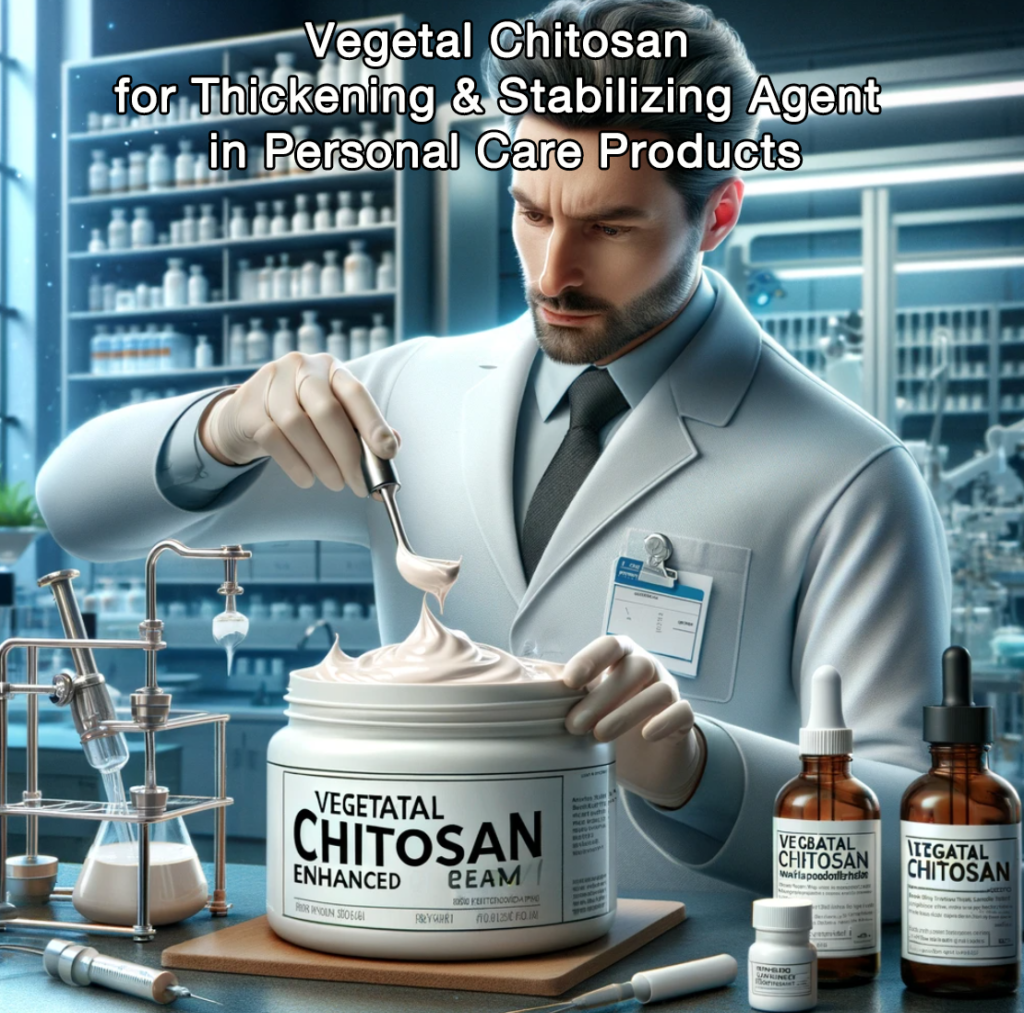
- Compatibility with Other Ingredients: Vegetal chitosan is compatible with a wide range of cosmetic ingredients, which facilitates its incorporation into various types of personal care formulations.

These properties make vegetal chitosan a versatile ingredient in the personal care industry, contributing to product effectiveness and enhancing consumer appeal.
4. In what specific areas of personal care & benefits can vegetal chitosan be used? and each functions & Concentration?
Personal care encompasses a wide range of products and applications aimed at maintaining and enhancing personal hygiene and beauty.
Vegetal chitosan, sourced from plants like mushrooms and fungi such as Aspergillus niger, is increasingly used in personal care products due to its biocompatibility and beneficial properties.
Here’s some of the primary areas within the personal care industry, and how vegetal chitosan functions across different personal care applications, along with general overview of how chitosan might be used in different personal care applications, including typical chitosan concentration ranges and formulation tips::
- Skin Care: This is perhaps the most extensive category and includes moisturizers, cleansers, toners, serums, exfoliators, sunscreens, and treatments for specific skin conditions like acne or eczema.
- Moisturizing: Chitosan helps retain moisture in the skin, which is essential for maintaining skin hydration and elasticity.
- Anti-aging: By forming a film on the skin, it can reduce the appearance of fine lines and wrinkles, giving the skin a smoother and firmer look.
- Antimicrobial: Its antimicrobial properties help in managing acne and reducing skin infections, making it suitable for use in face washes and acne treatments.
- Concentration: Typically, 0.1% to 2% of chitosan is used.
- Guidelines: Chitosan should be dissolved in acidic water (pH around 5.5) for best solubility before being added to the formulation. It can be used in serums, creams, and gels to enhance moisturizing effects and film formation.

- Hair Care: Products in this category include shampoos, conditioners, hair masks, serums, and styling products such as hairsprays, gels, and mousses.
- Shine and Strength: Chitosan can coat hair strands, enhancing their shine and reducing breakage by strengthening the hair cuticle.
- Scalp Health: The antimicrobial properties of chitosan also support scalp health by preventing dandruff and other scalp-related issues.
- Concentration: About 0.5% to 1.5% is common.
- Guidelines: For shampoos and conditioners, chitosan can be added to the water phase. It can help in forming a film on hair, enhancing shine and strength. Ensure compatibility with surfactants.

- Oral Care: This includes toothpaste, mouthwashes, dental floss, and other products aimed at dental health.
- Plaque Prevention: Chitosan’s ability to bind to bacteria and particles makes it useful in toothpastes and mouthwashes to help reduce plaque and control tartar.
- Gum Health: Its anti-inflammatory properties can aid in reducing gum inflammation and promoting oral health.
- Concentration: Generally between 0.2% and 2%.
- Guidelines: Chitosan hydrochloride is particularly suitable due to its solubility. It can be incorporated into gels or mouthwashes where it aids in bacterial adhesion reduction and can promote oral health.
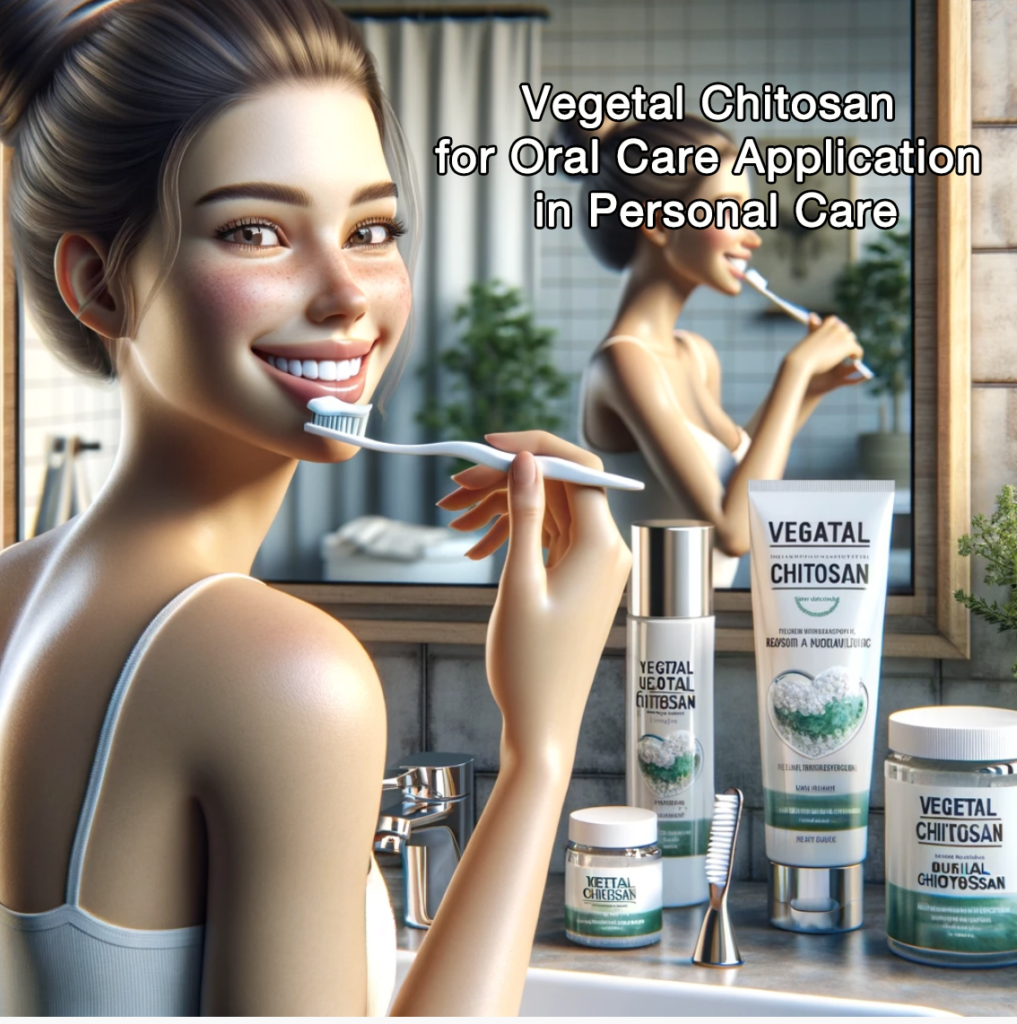
- Cosmetics: This broad category covers makeup products for the face, eyes, lips, and nails, including foundations, eyeshadows, lipsticks, blushes, and nail polishes.
- Film Forming: In makeup, chitosan can improve the adherence of products to the skin, enhancing the longevity of makeup.
- Moisturizing: Provides hydration without the greasiness, making it suitable for inclusion in foundations and lip products.
- Concentration: Typically around 0.1% to 1%.
- Guidelines: In make-up formulations, ensure that chitosan is well-dissolved and compatible with other ingredients. It can help improve the adherence of products to the skin and prolong wear.
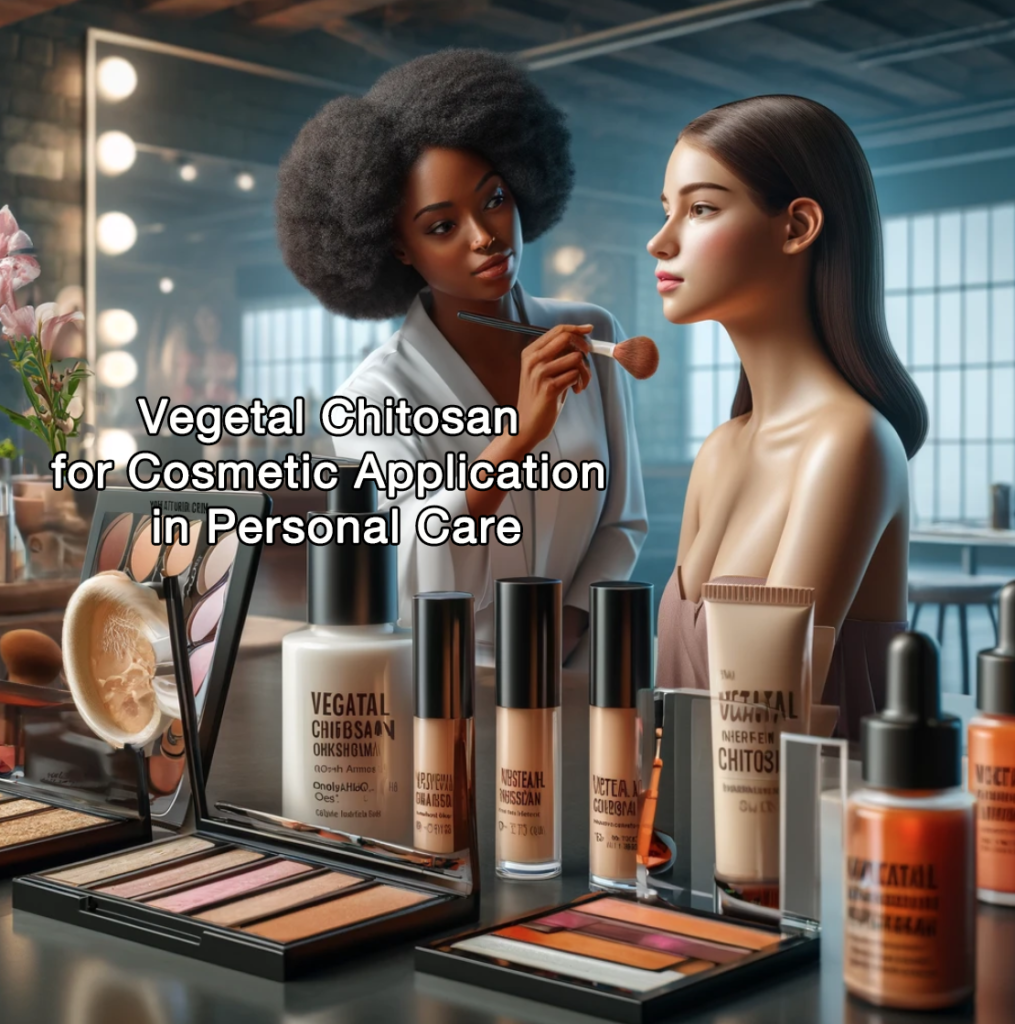
- Bath and Body: Products under this category include body washes, soaps, bath salts, body scrubs, and body lotions.
- Skin Protection: Forms a protective barrier on the skin that can shield against pollutants and irritants, beneficial in body lotions and protective creams.
- Hydration: Enhances moisture content in the skin, useful in body washes and hydrating body lotions.
- Concentration: Usually from 0.5% to 2%.
- Guidelines: In body lotions and washes, chitosan can be added to the water phase. It helps with moisture retention and forms a protective barrier on the skin.

- Deodorants and Antiperspirants: These products are designed to reduce body odor and control sweating.
- Odor Control: Its antimicrobial properties help reduce body odor by preventing the growth of bacteria that cause odor.
- Non-Irritating: Chitosan is less likely to irritate the skin compared to some other chemical agents used in deodorants.
- Concentration: About 0.5% to 1.5%.
- Guidelines: Can be incorporated into aqueous or alcoholic solutions. Chitosan helps reduce body odor by its antimicrobial properties and can also act as a skin conditioner.

- Men’s Grooming: This includes products specifically formulated for men, such as shaving creams, aftershaves, beard oils, and men’s skincare items.
- Soothing Properties: Useful in aftershave products to soothe and repair the skin post-shaving.
- Beard Care: In beard products, chitosan can help in conditioning and softening beard hair.
- Concentration: Generally around 0.5% to 2%.
- Guidelines: For products like shaving gels and aftershave balms, chitosan adds soothing and healing properties. Ensure it is well integrated into the base formulation.
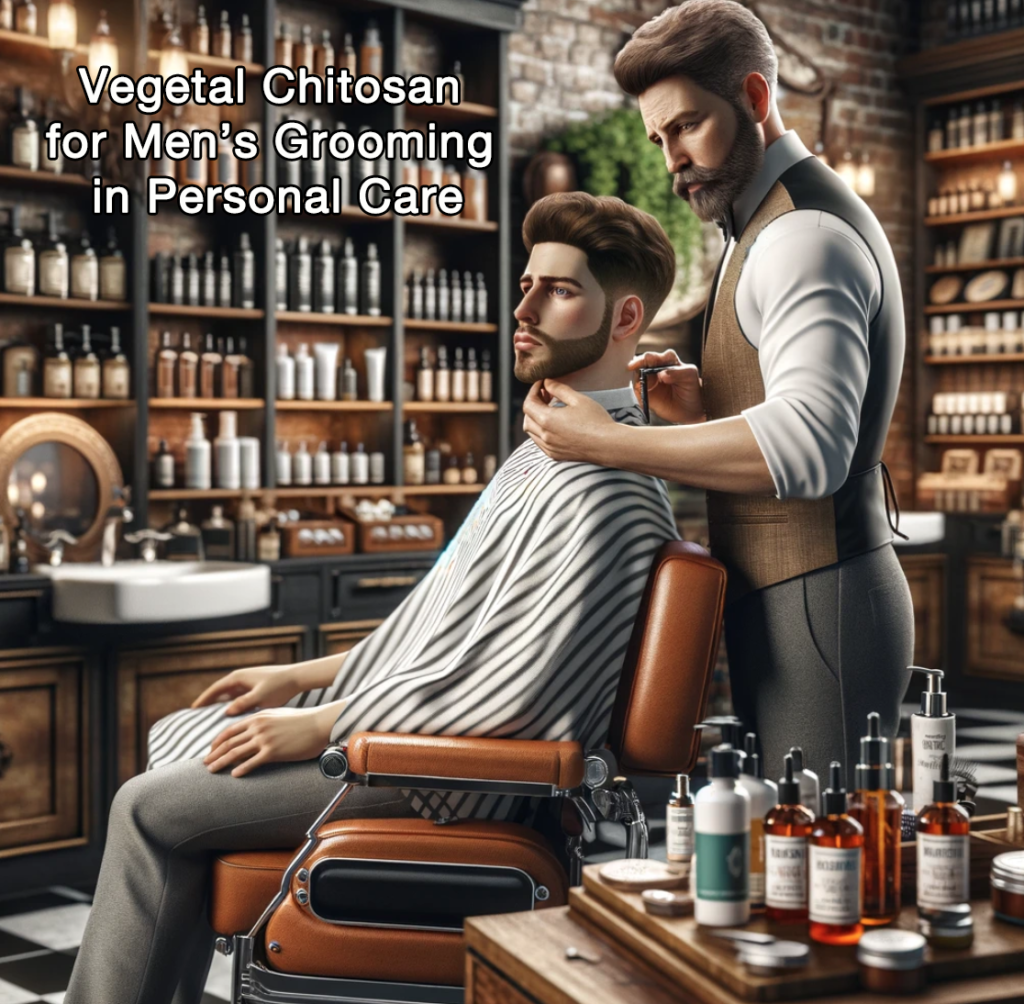
- Baby Care: Gentle products designed for infants and young children, including baby shampoos, body washes, lotions, and diaper rash creams.
- Gentle on Skin: Safe and non-irritating for use in baby shampoos and lotions, providing gentle care and moisture.
- Concentration: Typically 0.1% to 1%.
- Guidelines: Chitosan should be used in gentle concentrations and formulations, considering the sensitive nature of baby skin. It’s beneficial for its antimicrobial and skin-protecting properties.

- Feminine Hygiene: This category includes products such as sanitary pads, tampons, and intimate washes.
- Antimicrobial and Odor Control: Used in intimate washes and products to maintain hygiene and control odors without disrupting the natural pH.
- Concentration: About 0.2% to 1.5%.
- Guidelines: In products like intimate washes, chitosan offers odor control and mild antimicrobial effects. Ensure the product maintains a pH that is compatible with the sensitive areas of applications.

- Fragrances: Perfumes, colognes, and body sprays fall into this category.
- Fixative Properties: Can help in binding fragrances to the skin, enhancing the longevity of perfumes and scented body products.
- Concentration: Typically 0.1% to 0.5%.
- Guidelines: Chitosan can be used as a fixative to help fragrances last longer on the skin. It should be compatible with the alcohol and other components of the fragrance formulation.

Each of these areas includes products designed to cater to specific aspects of hygiene, health, and aesthetics, utilizing a variety of ingredients to meet consumer needs and preferences.
The versatility of vegetal chitosan makes it a valuable ingredient across various personal care products, contributing not only to the functional performance of these products but also enhancing their appeal to health-conscious consumers.
General Formulation Tips:
- Dissolve chitosan in acidic conditions (pH around 4-6) for better solubility, while it would vary depend on the type of chitosan used.
- Preparing a chitosan solution beforehand can ease the integration into the final product.
- Compatibility tests with other formulation ingredients are crucial to prevent precipitation and ensure stability.
- Adjust the viscosity of the final product if necessary, as chitosan can significantly impact the rheology.
These guidelines are general and may need to be adapted depending on the specific requirements and desired properties of the final product.
5. What are the common forms in which vegetal chitosan is used in personal care applications?
Vegetal chitosan can be incorporated into various personal care products in several forms, depending on the application and the desired effect. Here are some common forms in which vegetal chitosan is used in personal care applications:
- Powders: Often used in face masks, toothpastes, or as an additive in powders for body powders and dry shampoos. It can help absorb excess oil and moisture, and deliver the active benefits of chitosan directly to the skin or teeth.

- Gels:
- Chitosan gels are common in skincare products, such as moisturizers and eye gels. They are also used in hair styling products like hair gels, where they provide hold without flaking.
- In oral care, chitosan can be used in gel toothpastes or as a protective gel for gum treatment.

- Solutions and Extracts:
- Chitosan solutions are used in serums, toners, and essence products. These solutions can be applied directly to the skin for hydration and antimicrobial effects.
- Chitosan extracts are often found in liquid form in shampoos and conditioners, where they help to strengthen hair and enhance shine.

- Emulsions: Common in creams and lotions, where chitosan acts as a stabilizing agent and helps to form and maintain the emulsion. It provides a moisturizing barrier on the skin, which is especially beneficial in body lotions and face creams.
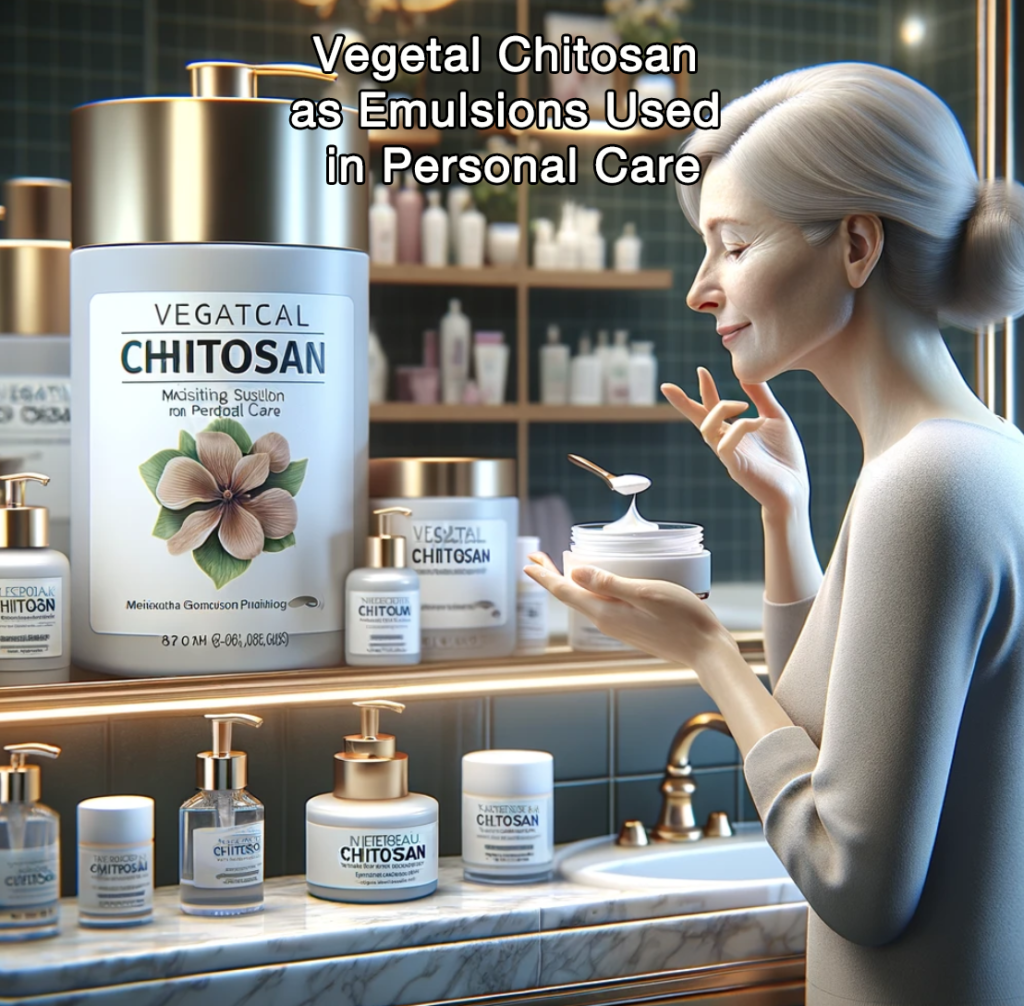
- Films:Chitosan films are used in peel-off masks or in wound care within the personal care sector. These films can form a protective layer on the skin, delivering active ingredients and then being peeled away to remove impurities from the skin surface.

- Capsules and Beads: In some cosmetic products, encapsulated chitosan is used for controlled release of the active ingredients. These can be found in age-defying skin treatments and advanced hair care formulations.

- Aerosols: Used in deodorants and some hair sprays, where chitosan provides antimicrobial benefits and helps with film formation without affecting the spray mechanism.

Each form of chitosan is chosen based on how well it can deliver the desired effects in a particular product type. For example, powders for absorbency, gels for smooth application, and emulsions for moisturizing effects. This versatility allows chitosan to be a beneficial ingredient across a wide range of personal care products.
6. Which type of vegetal chitosan is best suited for personal care applications?
Choosing the right type of vegetal chitosan for personal care applications depends on the specific product’s formulation requirements and the desired functional properties. Here’s a breakdown of the suitability of each type of chitosan for different personal care applications:
- Acid-Soluble Chitosan (with varying viscosities)
- 20-100 cps: Suitable for lightweight, non-greasy formulations such as serums, toners, and facial mists where quick absorption and light feel are desirable.
- 100-500 cps: Good for medium-viscosity applications like gels and emulsions where moderate thickness and stabilization are needed without heavy texture.
- 500-1000 cps: Best for thick creams, heavy gels, and masks where a thicker consistency is crucial for the product’s stability and performance.
- Chitosan Hydrochloride
- This form is highly soluble in water and mildly acidic to neutral pH, making it ideal for formulations where good solubility and pH stability are required. It’s suitable for eye gels, moisturizers, and wound healing applications due to its gentle nature on skin and mucous membranes.
- Chitosan Oligosaccharide
- Known for its excellent biocompatibility and low molecular weight, which allows for better skin penetration. This makes it ideal for anti-aging products, serums, and other skincare products aimed at deep skin repair and rejuvenation.
- Carboxymethyl Chitosan
- This derivative of chitosan is highly water-soluble and possesses strong moisturizing and anti-inflammatory properties. It’s particularly suitable for sensitive skin products, soothing creams, and lotions, as well as in hydrating sprays and after-sun products.
Application-specific Recommendations:
- Skin Care: Chitosan oligosaccharide and carboxymethyl chitosan are excellent for skin care due to their skin-friendly properties.
- Hair Care: Higher viscosity acid-soluble chitosan can be used in hair gels and conditioners for better film formation and strength.
- Oral Care: Chitosan hydrochloride is beneficial due to its solubility and mildness, ideal for mouthwashes and toothpastes.
- Cosmetics: Acid-soluble chitosan with lower viscosities is preferred in cosmetic formulations for a lighter feel.
- Deodorants and Antiperspirants: Chitosan hydrochloride due to its solubility and gentle effect on skin.
- Men’s Grooming: Carboxymethyl chitosan for soothing and moisturizing properties in aftershave and beard products.
Of course, selecting the appropriate type of chitosan enhances the product’s efficacy and consumer appeal by aligning its functional properties with the intended application.
7. What is the flowchart of vegetal chitosan processing?
The production process of plant chitosan is mainly obtained by extracting raw materials (mushrooms, Aspergillus niger), deproteinizing with dilute acid or alkali, deacetylating, drying, etc.
Here is a simplified flowchart of the production process of vegetal chitosan for your reference.
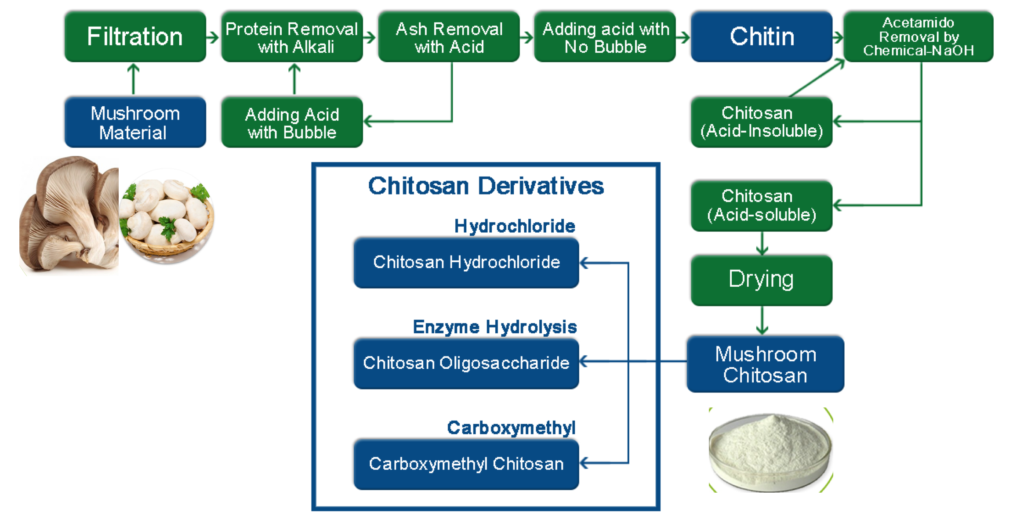
The flowchart of mushroom chitosan illustrates the process of producing chitosan and its derivatives from mushroom material. Here’s a summary of the key content:
- Starting Material: The process begins with mushroom material as the source.
- Filtration: The mushroom material undergoes a filtration process.
- Protein Removal: Proteins are then removed from the filtered material using an alkali solution.
- Ash Removal: Ash content is subsequently removed with acid.
- Chitin Extraction:
- Acid is added without bubbles to proceed to the next stage.
- Chitin is extracted, which is not soluble in acid.
- An acetylation step removes the acetyl groups from the chitin using sodium hydroxide (NaOH), converting it into chitosan, which is soluble in acid.
- Drying: The acid-soluble chitosan is then dried to produce the final mushroom chitosan product, showcased as a white powder.
- Chitosan Derivatives: Parallel to the drying process, there is a branch leading to the production of various chitosan derivatives:
- Chitosan Hydrochloride: Chitosan converted into its hydrochloride form.
- Enzyme Hydrolysis: Produces chitosan oligosaccharide through enzymatic hydrolysis.
- Carboxymethyl Chitosan: Derived through the carboxymethylation of chitosan.
The flowchart depicts a methodical approach to converting mushroom material into various forms of chitosan, focusing on the purification and chemical modification steps necessary to achieve different chitosan-based products for use in various applications.
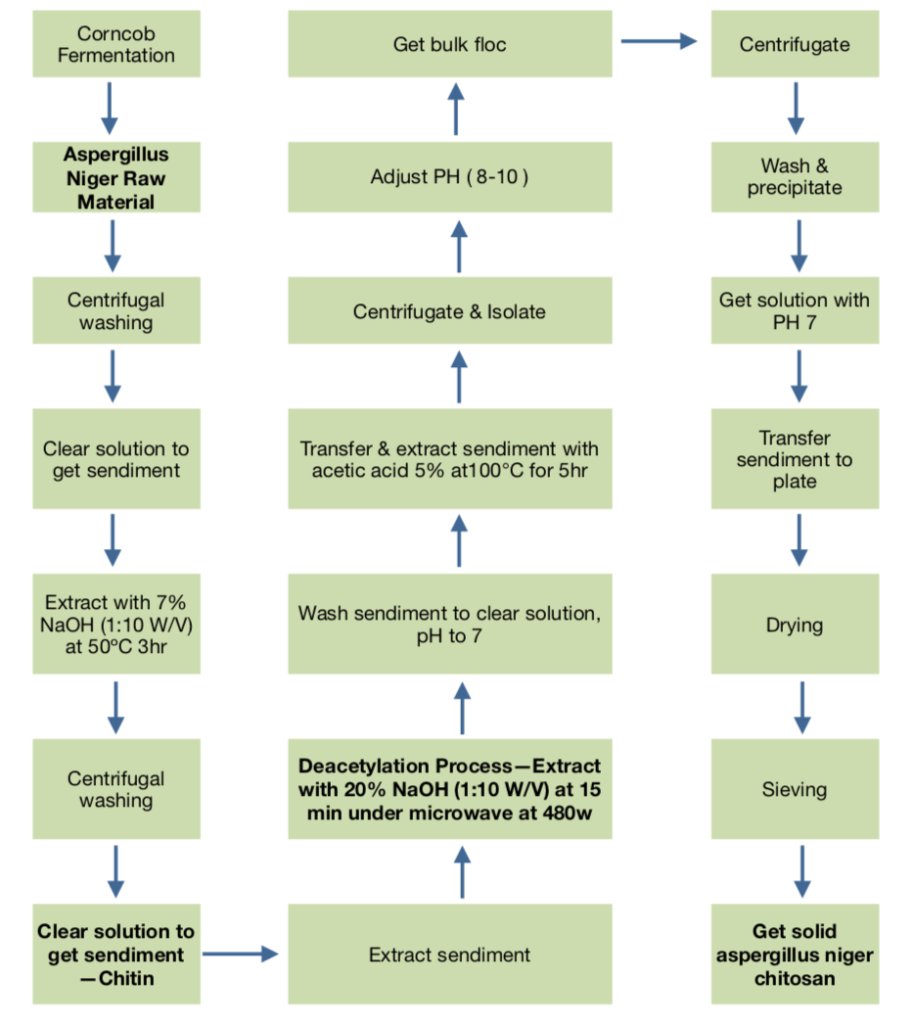
The flowchart of aspergillus niger chitosan outlines the process for extracting chitosan from Aspergillus niger, a type of fungus. Here’s a step-by-step summary of the key points:
- Starting Material: Aspergillus niger is cultured through a fermentation process using corn.
- Extraction:
- The fungal biomass undergoes a bulk flocculation.
- This is followed by centrifugation to separate the components.
- The pH of the resulting material is adjusted to alkaline conditions (pH 8-10).
- Another round of centrifugation and isolation occurs.
- The pH is adjusted back to neutral (pH 7), and the sediment is washed and precipitated.
- The sediment is then extracted with 5% acetic acid at 100°C for five hours to get the clear solution.
- It is washed again to achieve a clear solution with a neutral pH.
- Chitin Production:
- The clear solution is treated with 7% sodium hydroxide (NaOH) at a ratio of 1:10 (W/V) at 50°C for three hours.
- Centrifugal washing follows, resulting in the production of chitin as a clear solution to get the sediment.
- Deacetylation:
- The sediment undergoes the deacetylation process. It’s treated with 20% NaOH at a ratio of 1:10 (W/V) and heated in a microwave at 480W for 15 minutes.
- This step is crucial to convert chitin into chitosan by removing acetyl groups.
- Final Steps:
- The final sediment, which is now deacetylated chitin or chitosan, is extracted.
- It undergoes drying, followed by sieving to achieve the desired particle size.
- End Product: The final product is solid Aspergillus niger chitosan.
This process includes several steps involving pH adjustment, centrifugation, chemical treatments, and heating, which are critical to ensuring the purity and quality of the chitosan extracted from Aspergillus niger.
8. Summary of of vegetal chitosan used in personal care
Vegetal chitosan, derived from sources like mushrooms and Aspergillus niger, is increasingly valued in the personal care industry for its versatile and beneficial properties.
This biopolymer is used across a wide range of products, from skin care and hair care to oral and feminine hygiene.
In skin care, chitosan concentrations typically range from 0.1% to 2%, where it enhances moisture retention and provides anti-aging benefits by forming a film that tightens and smoothes the skin.
It’s also praised for its antimicrobial properties, which make it suitable for formulations targeting acne-prone skin or products like deodorants, where it helps reduce body odor by preventing bacterial growth.

In hair care products, chitosan is used in concentrations of about 0.5% to 1.5%, where it contributes to hair strength and shine by forming a protective film on each strand.
This not only improves the hair’s appearance but also protects it from environmental damage.
The use of chitosan extends to oral care products as well, particularly in the form of chitosan hydrochloride, which is appreciated for its ability to bind to bacteria and reduce plaque formation, included in products at concentrations ranging from 0.2% to 2%.
Whether enhancing the stability of emulsions in creams and lotions or improving the efficacy of hygiene products, chitosan’s role in personal care continues to grow, driven by consumer demand for natural and effective ingredients.

